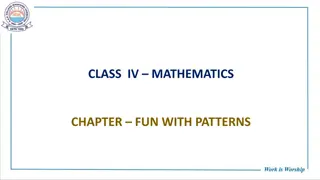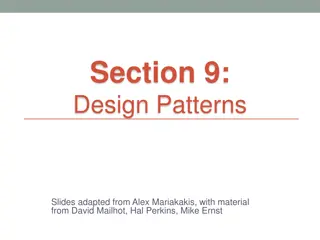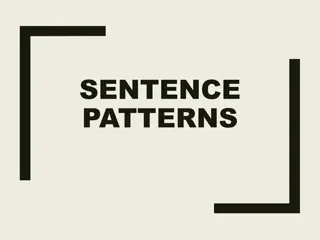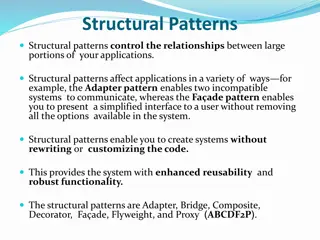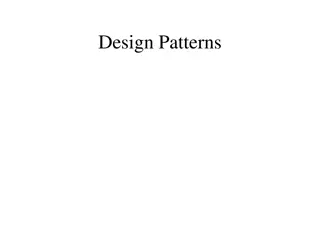
Software Design Patterns in CSE 331 Fall 2014 with Dan Grossman
Explore the structural patterns, including wrappers and adapters, in CSE 331 Software Design course from Fall 2014 with Dan Grossman. Understand how design patterns like Adapter and Delegate facilitate interface changes without affecting functionality, enabling seamless integration of new components into existing systems.
Download Presentation

Please find below an Image/Link to download the presentation.
The content on the website is provided AS IS for your information and personal use only. It may not be sold, licensed, or shared on other websites without obtaining consent from the author. If you encounter any issues during the download, it is possible that the publisher has removed the file from their server.
You are allowed to download the files provided on this website for personal or commercial use, subject to the condition that they are used lawfully. All files are the property of their respective owners.
The content on the website is provided AS IS for your information and personal use only. It may not be sold, licensed, or shared on other websites without obtaining consent from the author.
E N D
Presentation Transcript
CSE 331 Software Design & Implementation Dan Grossman Fall 2014 Design Patterns, Part 2 (Based on slides by Mike Ernst, David Notkin, Hal Perkins)
Outline Introduction to design patterns Creational patterns (constructing objects) Structural patterns (controlling heap layout) Behavioral patterns (affecting object semantics) CSE331 Fall 2014 2
Structural patterns: Wrappers A wrapper translates between incompatible interfaces Wrappers are a thin veneer over an encapsulated class Modify the interface Extend behavior Restrict access The encapsulated class does most of the work Pattern Adapter Decorator Proxy Functionality Interface same different same different same same Some wrappers have qualities of more than one of adapter, decorator, and proxy CSE331 Fall 2014 3
Adapter Change an interface without changing functionality Rename a method Convert units Implement a method in terms of another Example: angles passed in radians vs. degrees Example: use old method names for legacy code CSE331 Fall 2014 4
Adapter example: scaling rectangles We have this Rectangle interface interface Rectangle { // grow or shrink this by the given factor void scale(float factor); ... float getWidth(); float area(); } Goal: client code wants to use this library to implement Rectangle without rewriting code that uses Rectangle: class NonScaleableRectangle { // not a Rectangle void setWidth(float width) { ... } void setHeight(float height) { ... } // no scale method ... } CSE331 Fall 2014 5
Adapter: Use subclassing class ScaleableRectangle1 extends NonScaleableRectangle implements Rectangle { void scale(float factor) { setWidth(factor * getWidth()); setHeight(factor * getHeight()); } } CSE331 Fall 2014 6
Adapter: use delegation Delegation: forward requests to another object class ScaleableRectangle2 implements Rectangle { NonScaleableRectangle r; ScaleableRectangle2(float w, float h) { this.r = new NonScaleableRectangle(w,h); } void scale(float factor) { r.setWidth(factor * r.getWidth()); r.setHeight(factor * r.getHeight()); } float getWidth() { return r.getWidth(); } float circumference() { return r.circumference(); } ... } CSE331 Fall 2014 7
Subclassing vs. delegation Subclassing automatically gives access to all methods of superclass built in to the language (syntax, efficiency) Delegation permits removal of methods (compile-time checking) objects of arbitrary concrete classes can be wrapped multiple wrappers can be composed Delegation vs. composition Differences are subtle For CSE 331, consider them equivalent (?) CSE331 Fall 2014 8
Types of adapter Goal of adapter: connect incompatible interfaces Adapter with delegation Different interfaces Client Adaptor Implementation Client Implementation Adapter with subclassing: no extension is permitted Adapter with subclassing Implementation Implementation Implementation Subclass Client Adaptor Client Adaptor CSE331 Fall 2014 9
Decorator Add functionality without changing the interface Add to existing methods to do something additional (while still preserving the previous specification) Not all subclassing is decoration CSE331 Fall 2014 10
Decorator example: Bordered windows interface Window { // rectangle bounding the window Rectangle bounds(); // draw this on the specified screen void draw(Screen s); ... } class WindowImpl implements Window { ... } CSE331 Fall 2014 11
Bordered window implementations Via subclasssing: class BorderedWindow1 extends WindowImpl { void draw(Screen s) { super.draw(s); bounds().draw(s); } } Via delegation: class BorderedWindow2 implements Window { Window innerWindow; BorderedWindow2(Window innerWindow) { this.innerWindow = innerWindow; } void draw(Screen s) { innerWindow.draw(s); innerWindow.bounds().draw(s); } } CSE331 Fall 2014 Delegation permits multiple borders on a window, or a window that is both bordered and shaded 12
A decorator can remove functionality Remove functionality without changing the interface Example: UnmodifiableList What does it do about methods like add and put? Problem: UnmodifiableList is a Java subtype, but not a true subtype, of List Decoration via delegation can create a class with no Java subtyping relationship, which is often desirable CSE331 Fall 2014 13
Proxy Same interface and functionality as the wrapped class So, uh, why wrap it?... Control access to other objects Communication: manage network details when using a remote object Locking: serialize access by multiple clients Security: permit access only if proper credentials Creation: object might not yet exist (creation is expensive) Hide latency when creating object Avoid work if object is never used CSE331 Fall 2014 14
Composite pattern Composite permits a client to manipulate either an atomic unit or a collection of units in the same way So no need to always know if an object is a collection of smaller objects or not Good for dealing with part-whole relationships An extended example CSE331 Fall 2014 15
Composite example: Bicycle Bicycle Wheel Skewer Lever Body Cam Rod Hub Spokes Nipples Rim Tape Tube Tire Frame Drivetrain ... CSE331 Fall 2014 16
Methods on components abstract class BicycleComponent { int weight(); float cost(); } class Skewer extends BicycleComponent { float price; float cost() { return price; } } class Wheel extends BicycleComponent { float assemblyCost; Skewer skewer; Hub hub; ... float cost() { return assemblyCost + skewer.cost() + hub.cost() + ...; } } CSE331 Fall 2014 17
Composite example: Libraries Library Section (for a given genre) Shelf Volume Page Column Word Letter interface Text { String getText(); } class Page implements Text { String getText() { ... return concatenation of column texts ... } } CSE331 Fall 2014 18
Traversing composites Goal: perform operations on all parts of a composite Idea: generalize the notion of an iterator process the components of a composite in an order appropriate for the application Example: arithmetic expressions in Java How do we represent, say, x=foo*b+c/d; How do we traverse/process these expressions? CSE331 Fall 2014 19
Outline Introduction to design patterns Creational patterns (constructing objects) Structural patterns (controlling heap layout) Behavioral patterns (affecting object semantics) Already seen: Observer Will just do 2-3 related ones CSE331 Fall 2014 20
Representing Java code x = foo * b + c / d; = x + / * c d foo b CSE331 Fall 2014 21
Abstract syntax tree (AST) for Java code class PlusOp extends Expression { // + operation Expression leftExp; Expression rightExp; } class VarRef extends Expression { // variable use String varname; } class EqualOp extends Expression { // test a==b; Expression leftExp; // left-hand side: a in a==b Expression rightExp; // right-hand side: b in a==b } class CondExpr extends Expression { // a?b:c Expression testExp; Expression thenExp; Expression elseExp; } CSE331 Fall 2014 22
Object model vs. type hierarchy AST for a + b: (PlusOp) b a (VarRef) (VarRef) Class hierarchy for Expression: Expression PlusOp VarRef EqualOp CondExpr CSE331 Fall 2014 23
Operations on abstract syntax trees Need to write code for each entry in this table Types of Objects CondExpr EqualOp typecheck Operations print Question: Should we group together the code for a particular operation or the code for a particular expression? That is, do we group the code into rows or columns? Given an operation and an expression, how do we find the proper piece of code? CSE331 Fall 2014 24
Interpreter and procedural patterns Interpreter: collects code for similar objects, spreads apart code for similar operations Makes it easy to add types of objects, hard to add operations An instance of the Composite pattern Procedural: collects code for similar operations, spreads apart code for similar objects Makes it easy to add operations, hard to add types of objects The Visitor pattern is a variety of the procedural pattern (See also many offerings of CSE341 for an extended take on this question Statically typed functional languages help with procedural whereas statically typed object-oriented languages help with interpreter) CSE331 Fall 2014 25
Objects CondExpr EqualOp Interpreter pattern typecheck pretty-print Add a method to each class for each supported operation abstract class Expression { ... Type typecheck(); String prettyPrint(); } class EqualOp extends Expression { ... Type typecheck() { ... } String prettyPrint() { ... } } class CondExpr extends Expression { ... Type typecheck() { ... } String prettyPrint() { ... } } Dynamic dispatch chooses the right implementation, for a call like e.typeCheck() Overall type-checker spread across classes CSE331 Fall 2014 26
Objects CondExpr EqualOp Procedural pattern typecheck pretty-print Create a class per operation, with a method per operand type class Typecheck { Type typeCheckCondExpr(CondExpr e) { Type condType = typeCheckExpr(e.condition); Type thenType = typeCheckExpr(e.thenExpr); Type elseType = typeCheckExpr(e.elseExpr); if (condType.equals(BoolType) && thenType.equals(elseType))) return thenType; else return ErrorType; } Type tcEqualOp(EqualOp e) { ... } } CSE331 Fall 2014 How to invoke the right method for an expression e? 27
Definition of typeCheckExpr (using procedural pattern) class Typecheck { ... Type typeCheckExpr(Expression e) { if (e instanceof PlusOp) { return typeCheckPlusOp((PlusOp)e); } else if (e instanceof VarRef) { return typeCheckVarRef((VarRef)e); } else if (e instanceof EqualOp) { return typeCheckEqualOp((EqualOp)e); } else if (e instanceof CondExpr) { return typeCheckCondExpr((CondExpr)e); } else ... ... } } Need similar code for each operation CSE331 Fall 2014 Maintaining this code is tedious and error-prone No help from type-checker to get all the cases (unlike in functional languages) Cascaded if tests are likely to run slowly (in Java) 28
Visitor pattern: A variant of the procedural pattern Nodes (objects in the hierarchy) accept visitors for traversal Visitors visit nodes (objects) class SomeExpression extends Expression { void accept(Visitor v) { for each child of this node { child.accept(v); } v.visit(this); } } class SomeVisitor extends Visitor { void visit(SomeExpression n) { perform work on n } } CSE331 Fall 2014 n.accept(v)traverses the structure rooted at n, performing v's operation on each element of the structure 29
Example: accepting visitors class VarOp extends Expression { void accept(Visitor v) { v.visit(this); } class EqualsOp extends Expression { void accept(Visitor v) { leftExp.accept(v); rightExp.accept(v); v.visit(this); } } class CondOp extends Expression { void accept(Visitor v) { testExp.accept(v); thenExp.accept(v); elseExp.accept(v); v.visit(this); } } First visit all children Then pass self back to visitor The visitor has a visit method for each kind of expression, thus picking the right code for this kind of expression Overloading makes this look more magical than it is Lets clients provide unexpected visitors CSE331 Fall 2014 30
Sequence of calls to accept and visit a.accept(v) b.accept(v) d.accept(v) v.visit(d) e.accept(v) v.visit(e) v.visit(b) c.accept(v) f.accept(v) v.visit(f) v.visit(c) v.visit(a) Sequence of calls to visit: d, e, b, f, c, a a b c d e f CSE331 Fall 2014 31
Example: Implementing visitors class TypeCheckVisitor implements Visitor { void visit(VarOp e) { } void visit(EqualsOp e) { } void visit(CondOp e) { } } Now each operation has its cases back together And type-checker should tell us if we fail to implement an abstract method in Visitor Again: overloading just a nicety class PrintVisitor implements Visitor { void visit(VarOp e) { } void visit(EqualsOp e) { } void visit(CondOp e) { } } Again: An OOP workaround for procedural pattern Because language/type- checker is not instance-of-test friendly CSE331 Fall 2014 32











